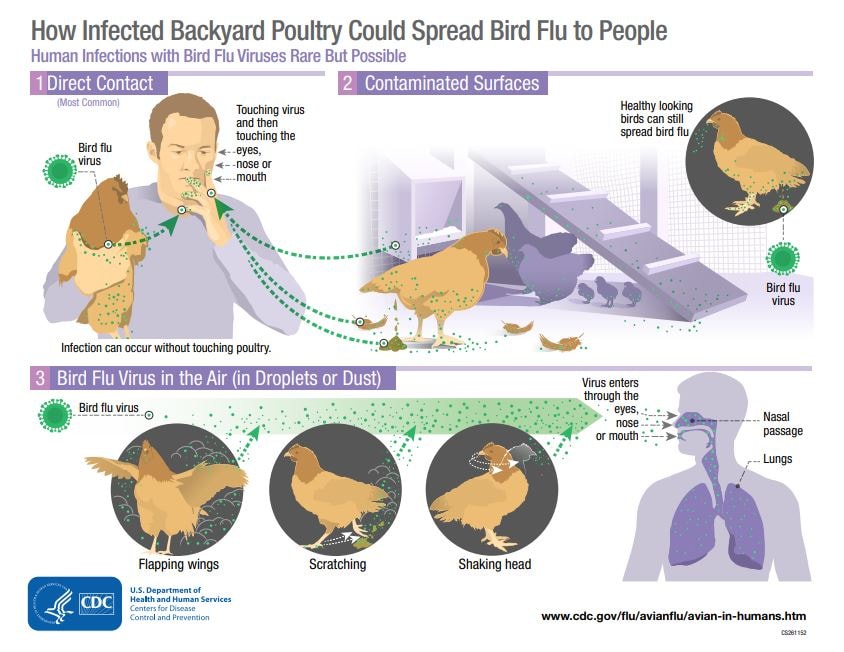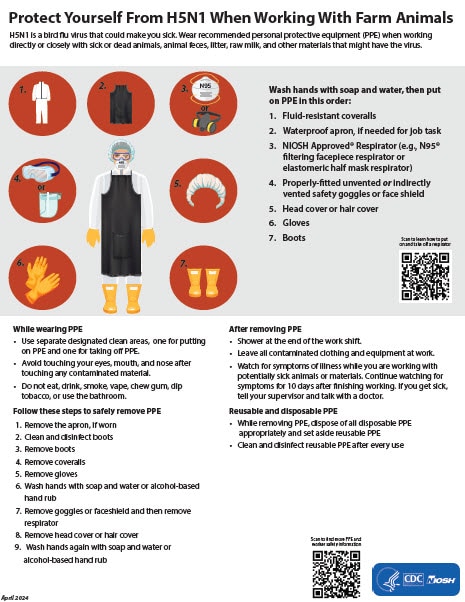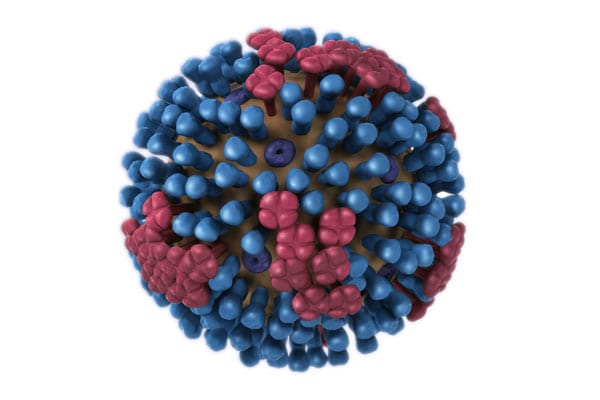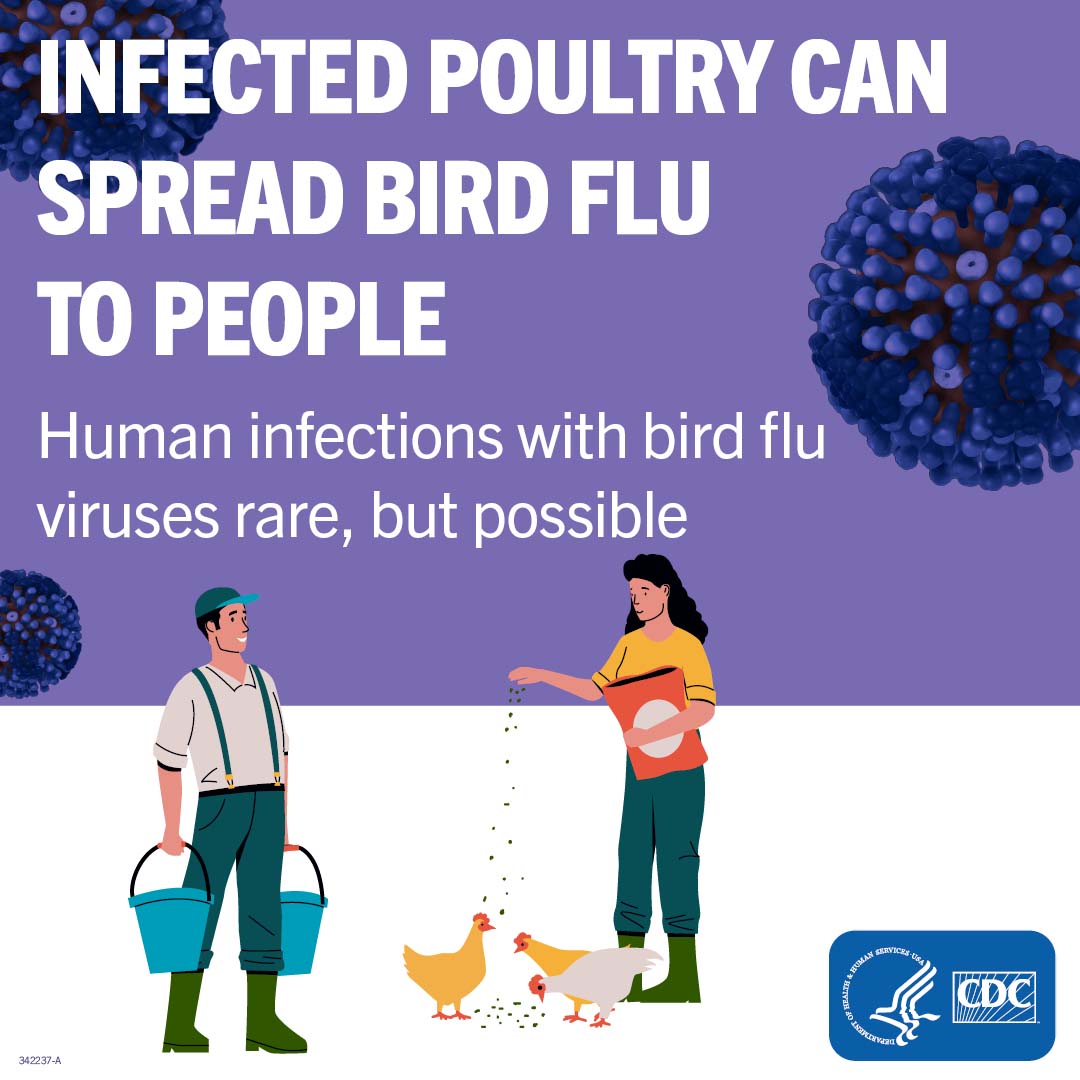Current U.S. Bird Flu Situation in Humans

This webpage summarizes the current avian influenza (bird flu) situation in humans in the United States.
Background
Avian influenza Type A viruses (bird flu viruses) do not normally infect people, but rare cases of human infection have occurred with some bird flu viruses. Illnesses in humans from bird flu virus infections have ranged in severity from no symptoms or mild illness (e.g., eye infection, upper respiratory symptoms) to severe disease (e.g., pneumonia) that resulted in death. Human infections with bird flu viruses have most often occurred after close or lengthy unprotected contact (i.e., not wearing gloves or respiratory protection or eye protection) with infected birds or places that sick birds or their saliva, mucous and feces have touched. Very rarely, human infections with bird flu viruses have happened through an intermediary animal, including a cat and a cow.
Human infections with bird flu viruses can happen when virus gets into a person’s eyes, nose or mouth, or is inhaled. This can happen when virus is in the air (in droplets or possibly dust) and a person breathes it in, or possibly when a person touches something that has virus on it and then touches their mouth, eyes or nose. The spread of bird flu viruses from one infected person to a close contact is very rare, and when it has happened, it has not led to continued spread among people. Six main hemagglutinin (HA) subtypes of bird flu viruses have infected people to cause acute respiratory illness (H3, H5, H6, H7, H9, and H10 viruses). Among these, H5N1 and H7N9 viruses have caused the majority of infections in people. More information about bird flu in humans is available at Bird Flu Virus Infections in Humans.
 [PDF - 555 KB, 2 pages]
[PDF - 555 KB, 2 pages]This graphic shows how bird flu viruses can spread between infected birds and people.
Current U.S. Bird Flu Situation in Humans
- Sporadic infections with highly pathogenic avian influenza A(H5N1) viruses in mammals have been reported in the United States, Canada, and other countries, but the risk to the general public from these viruses remains low.
- Two human cases of avian influenza A(H5N1) have been reported in the United States. More information about these cases is available: Highly Pathogenic Avian Influenza A (H5N1) Virus Infection Reported in a Person in the U.S.
- Only four human infections with low pathogenic avian influenza (LPAI)* A(H7N2) viruses resulting in mild-to-moderate illness have ever been identified in the United States.
The Current Risk to the General Public is Low
- The detections of H5 viruses in wild birds, poultry, some mammals, and in two people in the United States do not change the risk to the general public’s health, which CDC considers to be low. However, due to outbreaks in domestic commercial and backyard poultry flocks, and infections in wild birds and some mammals, some groups of people with job-related or recreational exposures to birds or other H5 virus-infected animals, are at greater risk of infection. People with job-related or recreational exposures to birds or infected mammals should take appropriate precautions to protect against bird flu.
-
Due to widespread circulation of A(H5N1) virus in wild birds and poultry and sporadic infections in mammals, additional sporadic human cases would not be surprising.
- Right now, the H5N1 bird flu situation remains primarily an animal health issue. However, CDC is watching this situation closely and taking routine preparedness and prevention measures in case this virus changes to pose a greater human health risk.
- Signals that could raise the public health risk include multiple, simultaneous reports of human infections with A(H5N1) viruses following exposure to birds or other animals, or identification of spread from one infected person to another.
- No known human-to-human spread has occurred with the contemporary A(H5N1) viruses that are currently circulating in birds in the United States and globally. In other countries, sporadic human cases of human infections with the A(H5N1) viruses most common in birds globally have been reported since 2022 mostly following exposure to infected poultry. During past A(H5N1) bird flu virus outbreaks that have occurred in poultry globally, human infections were rare. Globally since 2003, 23 countries have reported rare, sporadic human infections with A(H5N1) bird flu viruses to the World Health Organization (WHO). Monthly case counts are available on the WHO website.
- The spread of bird flu viruses from one infected person to a close contact has occurred rarely in other countries in the past, and when it has happened, it has been limited and not sustained, and did not spread beyond close contacts.
More Information about contemporary A(H5N1) Bird Flu Viruses
- USDA has publicly posted the genetic sequences of A(H5N1) bird flu viruses found in U.S. wild birds and poultry. The viruses are from clade 2.3.4.4b,** which is the most common A(H5N1) bird flu virus worldwide at this time. Comparing information about these contemporary viruses to previously circulating A(H5N1) bird flu viruses helps inform the human health risk assessment.
- CDC has been comparing the properties of contemporary A(H5N1) bird flu viruses to past A(H5N1) bird flu viruses and has found that contemporary A(H5N1) bird flu viruses detected in the U.S. during late 2021 and 2022 are different from earlier A(H5N1) bird flu viruses.
- Illness in humans from all bird flu virus infections has ranged in severity from no symptoms or mild illness to severe disease that resulted in death in other countries. Total case counts for all human infections with A(H5N1) viruses reported since 1997 are available.
- Occasional sporadic human infections with A(H5N1) viruses do not change the human risk assessment to the general public, which CDC considers to be low.
Additional Resources
- Health Alert Network (HAN) – 00506 | Highly Pathogenic Avian Influenza A(H5N1) Virus: Identification of Human Infection and Recommendations for Investigations and Response (cdc.gov)
- Highlights in the History of Avian Influenza (Bird Flu) Timeline – 2020-2024
- CDC and USDA have developed guidance for specific audiences with exposure to sick or dead birds, including the general public, hunters [296 KB, 2 pages], poultry producers, poultry outbreak responders, and health care providers.
- CDC has developed interim for Highly Pathogenic Avian Influenza A(H5N1) Virus in Animals.
- A handout containing information and guidance for people exposed to birds with bird flu is available at What To Know About Bird Flu (cdc.gov) [154 KB, 2 pages].
- More information about how to protect yourself against bird flu is available.
- More information is available from CDC spotlight articles.
*Highly pathogenic avian influenza (HPAI) and Low pathogenic avian influenza (LPAI) are described in the Classification of bird flu viruses section.
**Clades are described in the “Classification of bird flu viruses” section.

A flock of pintail ducks flying in winter. Northern pintail ducks are among the types of birds that A(H5N1) bird flu virus infections have been identified in the United States in 2022.



